 Each attraction has a story of its own. You can have a tour guide to get a better understanding of its history. Every stone Buddha in Peak Flown From Afar has its own story and has its own history. You can feel it with your heart. The environment is very fresh and refined, and the surrounding development is also very good. The northern peak behind Lingyin scenic spot also has a hiking trail, which is very suitable for hiking.
Each attraction has a story of its own. You can have a tour guide to get a better understanding of its history. Every stone Buddha in Peak Flown From Afar has its own story and has its own history. You can feel it with your heart. The environment is very fresh and refined, and the surrounding development is also very good. The northern peak behind Lingyin scenic spot also has a hiking trail, which is very suitable for hiking.
The stones on the mountain wall of Peak Flown From Afar have many Buddhist sculptures, and each sides has a lot of carvings, which is a bit like the Longmen Grottoes in Luoyang, and there is also One Line Sky. There is a small place on the huge cave to see the sky. Behind it, there is the pattern of the Western Heaven, and various auspicious patterns of the Buddha. In addition, calligraphy works can be carefully appreciated in the Peak Flown From Afar. It is an awesome scenic spot which features rivers, green hills, stone carvings, birds, fish, towering trees, green shades, etc. and the temple stands tall and has its own characteristics.

Peak Flown From Afar is a must-see destination in Hangzhou, which is rich in human history and natural history. There are mountains and water, and if you live in Hangzhou, you can go there once a week, as exercise. If you go to Hangzhou to travel, it is suitable to go to the Peak Flown From Afar at 7:30 a.m. to avoid the crowded people! Every scene in the Peak Flown From Afar is full of buddhist mood, and it is suitable for walking slowly, calm down your mood!
The scenery of Peak Flown From Afar is really good. Whether it is the scenery on the mountain or the Lingyin Temple under the mountain, it is very enjoyable. As a famous old attraction in Hangzhou, Peak Flown From Afar is a very good place to climb mountain and worship Budda.

 Thousand Islets Lake is located in the western suburbs of Hangzhou, Zhejiang Province, 129 kilometers east of Hangzhou and 130 kilometers west of Huangshan. It is the famous attraction in the famous travel itinerary line of Hangzhou – Thousand Islets Lake – Huangshan, which features famous city, famous lake and famous mountain. It forms an organic tourism network with Hangzhou West Lake, Anhui Huangshan, Xidi and Hongcun Ancient Water Town, Jiangxi Wuyuan, Sanqingshan, Fujian Wuyishan and other scenic spots. Thousand Islets Lake is located in the center of Zhejiang-Chongqing regional tourism cooperation, and from large cities such as Shanghai, Jiangsu, Anhui, Jiangxi, and Fujian, you can go straight to Thousand Islets Lake from the high-speed road.
Thousand Islets Lake is located in the western suburbs of Hangzhou, Zhejiang Province, 129 kilometers east of Hangzhou and 130 kilometers west of Huangshan. It is the famous attraction in the famous travel itinerary line of Hangzhou – Thousand Islets Lake – Huangshan, which features famous city, famous lake and famous mountain. It forms an organic tourism network with Hangzhou West Lake, Anhui Huangshan, Xidi and Hongcun Ancient Water Town, Jiangxi Wuyuan, Sanqingshan, Fujian Wuyishan and other scenic spots. Thousand Islets Lake is located in the center of Zhejiang-Chongqing regional tourism cooperation, and from large cities such as Shanghai, Jiangsu, Anhui, Jiangxi, and Fujian, you can go straight to Thousand Islets Lake from the high-speed road. When you are walking by the lake and look into the distance, you can see countless large and small islands in front of you. And when you are sitting on a speedboat to shuttle on the Thousand Island Lake, the cool breeze will drive the summer heat, to make you feel comfortable. If you want to see the most beautiful scenery of Thousand Island Lake, just climb up the top of Meifeng Island, from where you can see more than 300 islands of Thousand Island Lake, as well as Longshan Island, Lock Island, etc., all have their own unique scenery.
When you are walking by the lake and look into the distance, you can see countless large and small islands in front of you. And when you are sitting on a speedboat to shuttle on the Thousand Island Lake, the cool breeze will drive the summer heat, to make you feel comfortable. If you want to see the most beautiful scenery of Thousand Island Lake, just climb up the top of Meifeng Island, from where you can see more than 300 islands of Thousand Island Lake, as well as Longshan Island, Lock Island, etc., all have their own unique scenery. Mountain Putuo and Wutai Mountain in Shanxi, Mount Emei in Sichuan, and Jiuhua Mountain in Anhui Province are also known as the four famous mountains of Chinese Buddhism. It is the dojos of Guanyin Bodhisattva to educate all beings. Mountain Putuo is one of the 1390 islands in the Zhoushan Islands. It is covering an area of nearly 13 square kilometers. It faces the Shenjiamen of the Zhoushan Islands across the sea. It is known as the “Haitian Buddha Kingdom” and the “South China Sea Holy Land”. It is said to be the first batch of national key scenic spots.
Mountain Putuo and Wutai Mountain in Shanxi, Mount Emei in Sichuan, and Jiuhua Mountain in Anhui Province are also known as the four famous mountains of Chinese Buddhism. It is the dojos of Guanyin Bodhisattva to educate all beings. Mountain Putuo is one of the 1390 islands in the Zhoushan Islands. It is covering an area of nearly 13 square kilometers. It faces the Shenjiamen of the Zhoushan Islands across the sea. It is known as the “Haitian Buddha Kingdom” and the “South China Sea Holy Land”. It is said to be the first batch of national key scenic spots.
 After you climb the Six Harmonious Pagoda, you can watch the panoramic view there, which is truly spectacular and worthy a look! Six Harmonious Pagoda actually has 13 layers, seven layers can be seen and the other six layers are invisible and each double layer cannot be climbed up, so when you climb up 1 layer, it is actually equivalent to two layers of tower height. Each layer is hanging with one plaque that is said to be titled with four words starting from one to seven by Kangxi. It is also a reminder of the floor for the descendants. Because the tower has a long history, the stairs are rotating, the steps are very narrow and a little steep. There is a circle on each floor to see the Qiantang River. The top of the tower is the highest and best observation point to view the Qiantangjiang River! Even if the visibility is not very high, you can still feel the broad river.
After you climb the Six Harmonious Pagoda, you can watch the panoramic view there, which is truly spectacular and worthy a look! Six Harmonious Pagoda actually has 13 layers, seven layers can be seen and the other six layers are invisible and each double layer cannot be climbed up, so when you climb up 1 layer, it is actually equivalent to two layers of tower height. Each layer is hanging with one plaque that is said to be titled with four words starting from one to seven by Kangxi. It is also a reminder of the floor for the descendants. Because the tower has a long history, the stairs are rotating, the steps are very narrow and a little steep. There is a circle on each floor to see the Qiantang River. The top of the tower is the highest and best observation point to view the Qiantangjiang River! Even if the visibility is not very high, you can still feel the broad river.
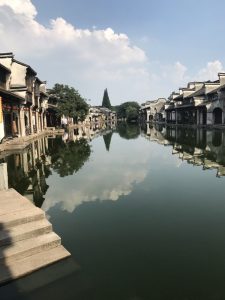 Nanxun ancient town is the new national 5A-level tourist scenic spot, and compared with Wuzhen and other over-developed Jiangnan water towns, tourists and commercial atmosphere in Nanxun Ancient Town are less, so it is worth a visit. Located in Nanxun District of Huzhou City, Nanxun ancient town is located at the junction of Jiangsu, Zhejiang and Shanghai. In the Ming and Qing Dynasties, it was a famous silk town in the south of the Yangtze River. It is an ancient town in the south of the Yangtze River with abundant human resources and features the combination of Chinese and Western architecture. The Nanxun ancient town is divided into three major blocks. The first piece is the Nanxun tourist attraction enrichment area, where Zhang Shiming’s former residence and Liu’s Ladder are distributed. The second block is a central scenic spot consisting of Xiaolianzhuang, Jiayetang and Wenyuan. The third block is the former residence of Zhang Jingjiang and the northeast block, which is mainly at the east of Dongda Street.
Nanxun ancient town is the new national 5A-level tourist scenic spot, and compared with Wuzhen and other over-developed Jiangnan water towns, tourists and commercial atmosphere in Nanxun Ancient Town are less, so it is worth a visit. Located in Nanxun District of Huzhou City, Nanxun ancient town is located at the junction of Jiangsu, Zhejiang and Shanghai. In the Ming and Qing Dynasties, it was a famous silk town in the south of the Yangtze River. It is an ancient town in the south of the Yangtze River with abundant human resources and features the combination of Chinese and Western architecture. The Nanxun ancient town is divided into three major blocks. The first piece is the Nanxun tourist attraction enrichment area, where Zhang Shiming’s former residence and Liu’s Ladder are distributed. The second block is a central scenic spot consisting of Xiaolianzhuang, Jiayetang and Wenyuan. The third block is the former residence of Zhang Jingjiang and the northeast block, which is mainly at the east of Dongda Street.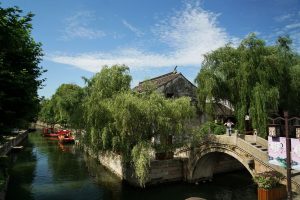 There are many delicious foods in Nanxun, such as mulberry wine, Huntun, big rice-pudding, stinky tofu, smoked bean tea, orange cake, mulberry leaf tea, glutinous rice candy, ham stir-fried screws, steamed white water fish, mulberry dried fruit and other foods. The fried fish noodles in various restaurants in Nanxun ancient town is very special and worth a try.
There are many delicious foods in Nanxun, such as mulberry wine, Huntun, big rice-pudding, stinky tofu, smoked bean tea, orange cake, mulberry leaf tea, glutinous rice candy, ham stir-fried screws, steamed white water fish, mulberry dried fruit and other foods. The fried fish noodles in various restaurants in Nanxun ancient town is very special and worth a try.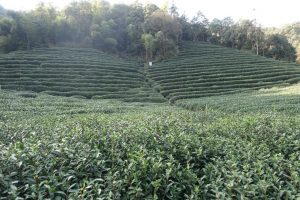 Meijiawu is a village hidden deep in tea mountain. When you are there, you will wonder how happy people lives here, as there is good environment and air and it is like a fairyland on earth. In the morning, mist lingers in Meijiawu, and the rainy clouds shrouded. For the tea in the mountains, the fog around it makes it a smart world, which is cool, pure, and ethereal. There is green scenery here and there, and you can close your eyes and listen quietly. The insects in the grass and the various birds are melodious. When the breeze blows, and the various leaves are intertwined and undulate. Between the flower and bamboo rhyme, you want to try to identify the fragrance, but the harder you work, the more you look for it, then the harder you can make it clear. For the transparency of the glass, when you are looking out through the pure water, it becomes a cup of tea without any impurities, and the yellow-green water shadow is pure and tolerant, and the cup is calm.
Meijiawu is a village hidden deep in tea mountain. When you are there, you will wonder how happy people lives here, as there is good environment and air and it is like a fairyland on earth. In the morning, mist lingers in Meijiawu, and the rainy clouds shrouded. For the tea in the mountains, the fog around it makes it a smart world, which is cool, pure, and ethereal. There is green scenery here and there, and you can close your eyes and listen quietly. The insects in the grass and the various birds are melodious. When the breeze blows, and the various leaves are intertwined and undulate. Between the flower and bamboo rhyme, you want to try to identify the fragrance, but the harder you work, the more you look for it, then the harder you can make it clear. For the transparency of the glass, when you are looking out through the pure water, it becomes a cup of tea without any impurities, and the yellow-green water shadow is pure and tolerant, and the cup is calm.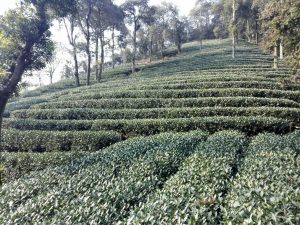 For the households under the mountains in Meijiawu, almost every household has their own tea garden, and now they no longer use the tea as a livelihood, but tea is a love that they have passed down from generation to generation. It is a habit that has already been integrated into life. It is an annual hope. Some residents along the street set up parasols, open small teahouses, and the small farmhouses are simple and natural. The tea is mellow and carries the charm of Jiangnan culture. The quaint signboards engrave the landscape and aura, waiting for the people to come to Meijiawu, to taste a cup of fragrant tea.
For the households under the mountains in Meijiawu, almost every household has their own tea garden, and now they no longer use the tea as a livelihood, but tea is a love that they have passed down from generation to generation. It is a habit that has already been integrated into life. It is an annual hope. Some residents along the street set up parasols, open small teahouses, and the small farmhouses are simple and natural. The tea is mellow and carries the charm of Jiangnan culture. The quaint signboards engrave the landscape and aura, waiting for the people to come to Meijiawu, to taste a cup of fragrant tea.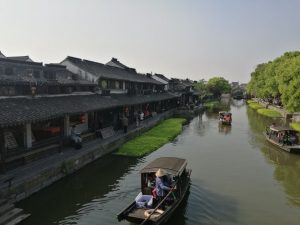 When you make your trip to Xitang Ancient Town from Shanghai, the Shanghai Bus Terminal and South Bus Station have direct bus to Xitang Ancient Town. It is very convenient. You can book an inn on the Internet and tell the boss to pick up you in the station (provided the boss is not busy). If the inn is inside the scenic spot and you don’t want to see the 11 small attractions inside, the tickets for the scenic spots can be saved. And there will be free of charge for the ancient town before 8:00 o’clock in the morning and after 17:00 o’clock in the afternoon. As long as it is not during holiday, you can pick the inns one by one until you feel satisfied with yourself (the small alley in the ancient town is full of inns).
When you make your trip to Xitang Ancient Town from Shanghai, the Shanghai Bus Terminal and South Bus Station have direct bus to Xitang Ancient Town. It is very convenient. You can book an inn on the Internet and tell the boss to pick up you in the station (provided the boss is not busy). If the inn is inside the scenic spot and you don’t want to see the 11 small attractions inside, the tickets for the scenic spots can be saved. And there will be free of charge for the ancient town before 8:00 o’clock in the morning and after 17:00 o’clock in the afternoon. As long as it is not during holiday, you can pick the inns one by one until you feel satisfied with yourself (the small alley in the ancient town is full of inns).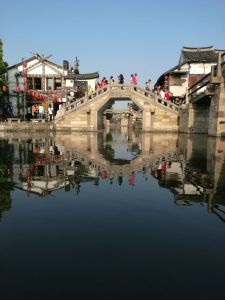
 Wuzhen is located in Tongxiang City, adjacent to Nanxun District of Huzhou City in Zhejiang Province. It has a long history of more than 1,300 years. It belongs to the six major water towns in the south of the Yangtze River. Whether it is from Shanghai, Suzhou, Hangzhou, Shaoxing, you can take a high-speed rail, or take the intercity express free travel, and a day trip to there, as it features great accessibility.
Wuzhen is located in Tongxiang City, adjacent to Nanxun District of Huzhou City in Zhejiang Province. It has a long history of more than 1,300 years. It belongs to the six major water towns in the south of the Yangtze River. Whether it is from Shanghai, Suzhou, Hangzhou, Shaoxing, you can take a high-speed rail, or take the intercity express free travel, and a day trip to there, as it features great accessibility.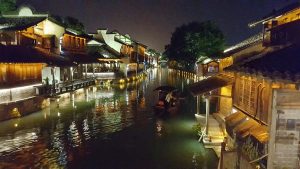
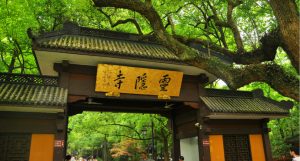 Adjacent to the West Lake, LingYin Temple is one of the earliest Buddhist monasteries in China and one of China’s top ten ancient temples, which is retaining many fine cultural relics of various dynasties. It has collected a lot of Treasures in the Temple: The “Yunlin Temple” horizontal inscribed board hanging on the Hall of Heavenly Kings is titled by Emperor Kangxi of Qing Dynasty; the Daxiong Hall is dedicated to the statue of Sakyamuni in the largest woodcarving Buddha statue in China. There are Buddhist relics in the temple, such as the ancient Beiye scriptures, and the Ming Dynasty’s writings of Diamond Sutra. There are many fantastic and varied caves on the mountain. There are more than 340 Buddhist statues in the five generations. It is a rare ancient stone art treasure in Jiangnan. Here is the birthplace of Jigong. It is said that the wish here is very effective, and the pilgrims who come to worship the Buddha every day are so a lot.
Adjacent to the West Lake, LingYin Temple is one of the earliest Buddhist monasteries in China and one of China’s top ten ancient temples, which is retaining many fine cultural relics of various dynasties. It has collected a lot of Treasures in the Temple: The “Yunlin Temple” horizontal inscribed board hanging on the Hall of Heavenly Kings is titled by Emperor Kangxi of Qing Dynasty; the Daxiong Hall is dedicated to the statue of Sakyamuni in the largest woodcarving Buddha statue in China. There are Buddhist relics in the temple, such as the ancient Beiye scriptures, and the Ming Dynasty’s writings of Diamond Sutra. There are many fantastic and varied caves on the mountain. There are more than 340 Buddhist statues in the five generations. It is a rare ancient stone art treasure in Jiangnan. Here is the birthplace of Jigong. It is said that the wish here is very effective, and the pilgrims who come to worship the Buddha every day are so a lot.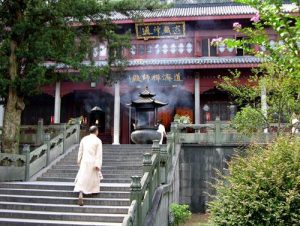 Tips: during Buddha’s birthday, national holidays, the Linyin Temple will be open 30 minutes in advance in the morning.
Tips: during Buddha’s birthday, national holidays, the Linyin Temple will be open 30 minutes in advance in the morning.
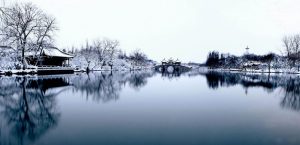 You may have heard from the adults that ” Up in heaven there is a paradise. Down on earth there are Suzhou and Hangzhou. ” Suzhou and Hangzhou are as beautiful as paradise on earth. Hangzhou, known as “paradise on earth”, is inlaid with a shining pearl, that is, the West Lake.
You may have heard from the adults that ” Up in heaven there is a paradise. Down on earth there are Suzhou and Hangzhou. ” Suzhou and Hangzhou are as beautiful as paradise on earth. Hangzhou, known as “paradise on earth”, is inlaid with a shining pearl, that is, the West Lake.